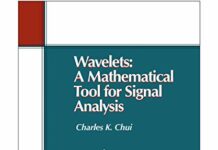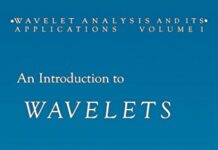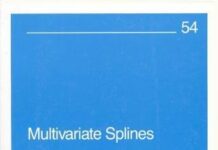
Ebook Info
- Published: 2009
- Number of pages: 244 pages
- Format: PDF
- File Size: 5.92 MB
- Authors: Charles K. Chui
Description
“Kalman Filtering with Real-Time Applications” presents a thorough discussion of the mathematical theory and computational schemes of Kalman filtering. The filtering algorithms are derived via different approaches, including a direct method consisting of a series of elementary steps, and an indirect method based on innovation projection. Other topics include Kalman filtering for systems with correlated noise or colored noise, limiting Kalman filtering for time-invariant systems, extended Kalman filtering for nonlinear systems, interval Kalman filtering for uncertain systems, and wavelet Kalman filtering for multiresolution analysis of random signals. The last two topics are new additions to this third edition. Most filtering algorithms are illustrated by using simplified radar tracking examples. The style of the book is informal, and the mathematics is elementary but rigorous. The text is self-contained, suitable for self-study, and accessible to all readers with a minimum knowledge.
User’s Reviews
Editorial Reviews: Review From the reviews:“To summarize, the authors have succeeded in bringing together the mathematical theory and the needs of practitioners. The newly added chapters, in particular the one on wavelets, give the book a proper finish. For a book of this size, it leaves little to be desired. It presents a wealth of details while at the same time avoiding unnecessary abstraction.” (Andreas Ruppin, Berlin, Germany (SSN Stat. Software News, 2000, 34,3-4)”A rigorous and concise introduction to Kalman filtering is presented in this well-written book. It is suitable for graduate studies, as well as refresher courses and self-study. … One of the strong features of the book is that Kalman filtering is presented from a few different viewpoints. … The many end-of-chapters exercises–and the section at the end of the book with solutions and hints to several of them–are another strong feature of the book.” (Vladimir Botchev, ACM Computing Reviews, July, 2009)From the reviews of the third edition:“The proofs and derivations in the third edition of Kalman Filtering with Real-Time Applications lead to a deep understanding of the linear Kalman filter algorithm as an optimal estimator for the state sequence in a system with stochastic dynamics and measurements. It is a good book for researchers with a strong mathematical background who will be building Kalman filters and smoothers. It is also a good text for teaching a course on linear Kalman filtering and some of its extensions.” (Bradley M. Bell, SIAM Review, Vol. 52 (2), 2010)From the reviews of the fourth edition:“It is written not only for self-study but also for use in a one-quarter or one-semester introductory course on Kalman filtering theory for upper-division undergraduate or first-year graduate to applied mathematics or engineering students. In addition, it is hoped that it will become a valuable reference to any industrial or government engineer.” (George S. Stavrakakis, Zentralblatt MATH, Vol. 1206, 2011) From the Back Cover Kalman Filtering with Real-Time Applications presents a thorough discussion of the mathematical theory and computational schemes of Kalman filtering. The filtering algorithms are derived via different approaches, including a direct method consisting of a series of elementary steps, and an indirect method based on innovation projection. Other topics include Kalman filtering for systems with correlated noise or colored noise, limiting Kalman filtering for time-invariant systems, extended Kalman filtering for nonlinear systems, interval Kalman filtering for uncertain systems, and wavelet Kalman filtering for multiresolution analysis of random signals. Most filtering algorithms are illustrated by using simplified radar tracking examples. The style of the book is informal, and the mathematics is elementary but rigorous. The text is self-contained, suitable for self-study, and accessible to all readers with a minimum knowledge of linear algebra, probability theory, and system engineering.
Reviews from Amazon users which were colected at the time this book was published on the website:
⭐The book is nonsense in the sense that it is a collection of dry math derived eqauations. No explanation and motivation are given behind the derivations.
⭐At first glance, I wouldn’t say this book is for beginners since it is not aimed to “give an idea” of “how it works” or generalities like that. After a short review of Matrices and Probabilities (join distributions), it goes directly to the math formulation of the filter.Of course, a beginner can take this book IF (s)he is at ease with matrices/linear algebra, and knows already the generalities of how the Kalman filter works. Then this book will give a good math foundation, which it is the goal of the book in my opinion. You will see theorems, proofs, demonstrations, some examples yes, but not a lot of projects to implement nor codes. It has a chapter combining Kalman filters with Wavelet filters which ultimately made buy the book. Just in case: I started as beginner, I got the general idea of Kalman, examples and basic Matlab® codes from internet, and this book was good to satisfy my Math-hunger.
⭐Good Book
⭐
⭐
Keywords
Free Download Kalman Filtering: with Real-Time Applications in PDF format
Kalman Filtering: with Real-Time Applications PDF Free Download
Download Kalman Filtering: with Real-Time Applications 2009 PDF Free
Kalman Filtering: with Real-Time Applications 2009 PDF Free Download
Download Kalman Filtering: with Real-Time Applications PDF
Free Download Ebook Kalman Filtering: with Real-Time Applications




